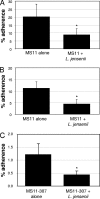Lactobacillus jensenii surface-associated proteins inhibit Neisseria gonorrhoeae adherence to epithelial cells
- PMID: 20385752
- PMCID: PMC2897381
- DOI: 10.1128/IAI.01200-09
Lactobacillus jensenii surface-associated proteins inhibit Neisseria gonorrhoeae adherence to epithelial cells
Erratum in
- Infect Immun. 2012 Oct;80(10):3743
Abstract
High numbers of lactobacilli in the vaginal tract have been correlated with a decreased risk of infection by the sexually transmitted pathogen Neisseria gonorrhoeae. We have previously shown that Lactobacillus jensenii, one of the most prevalent microorganisms in the healthy human vaginal tract, can inhibit gonococcal adherence to epithelial cells in culture. Here we examined the role of the epithelial cells and the components of L. jensenii involved in the inhibition of gonococcal adherence. L. jensenii inhibited the adherence of gonococci to glutaraldehyde-fixed epithelial cells like it inhibited the adherence of gonococci to live epithelial cells, suggesting that the epithelial cells do not need to be metabolically active for the inhibition to occur. In addition, methanol-fixed L. jensenii inhibited gonococcal adherence to live epithelial cells, indicating that L. jensenii uses a constitutive component to inhibit gonococcal interactions with epithelial cells. Proteinase K treatment of methanol-fixed lactobacilli eliminated the inhibitory effect, suggesting that the inhibitory component contains protein. Released surface components (RSC) isolated from L. jensenii were found to contain at least two inhibitory components, both of which are protease sensitive. Using anion-exchange and size exclusion chromatography, an inhibitory protein which exhibits significant similarity to the enzyme enolase was isolated. A recombinant His6-tagged version of this protein was subsequently produced and shown to inhibit gonococcal adherence to epithelial cells in a dose-dependent manner.
Figures








Similar articles
-
Inhibition of Neisseria gonorrhoeae epithelial cell interactions by vaginal Lactobacillus species.Infect Immun. 2008 Jul;76(7):3124-30. doi: 10.1128/IAI.00101-08. Epub 2008 Apr 14. Infect Immun. 2008. PMID: 18411284 Free PMC article.
-
A Moonlighting Enolase from Lactobacillus gasseri does not Require Enzymatic Activity to Inhibit Neisseria gonorrhoeae Adherence to Epithelial Cells.Probiotics Antimicrob Proteins. 2015 Sep;7(3):193-202. doi: 10.1007/s12602-015-9192-8. Probiotics Antimicrob Proteins. 2015. PMID: 25917402
-
Lactobacillus crispatus and its enolase and glutamine synthetase influence interactions between Neisseria gonorrhoeae and human epithelial cells.J Microbiol. 2020 May;58(5):405-414. doi: 10.1007/s12275-020-9505-9. Epub 2020 Apr 11. J Microbiol. 2020. PMID: 32279277
-
Adherence of clinically isolated lactobacilli to human cervical cells in competition with Neisseria gonorrhoeae.Microbes Infect. 2008 Oct;10(12-13):1325-34. doi: 10.1016/j.micinf.2008.07.032. Epub 2008 Aug 9. Microbes Infect. 2008. PMID: 18761100
-
Gonococcal adherence: selected topics.Rev Infect Dis. 1983 Sep-Oct;5 Suppl 4:S678-84. doi: 10.1093/clinids/5.supplement_4.s678. Rev Infect Dis. 1983. PMID: 6138846 Review.
Cited by
-
Lactobacilli Interfere with Streptococcus pyogenes Hemolytic Activity and Adherence to Host Epithelial Cells.Front Microbiol. 2016 Jul 29;7:1176. doi: 10.3389/fmicb.2016.01176. eCollection 2016. Front Microbiol. 2016. PMID: 27524981 Free PMC article.
-
Role of Sortase A in Lactobacillus gasseri Kx110A1 Adhesion to Gastric Epithelial Cells and Competitive Exclusion of Helicobacter pylori.Front Microbiol. 2019 Dec 3;10:2770. doi: 10.3389/fmicb.2019.02770. eCollection 2019. Front Microbiol. 2019. PMID: 31849907 Free PMC article.
-
Mitigation of the Toxic Effects of Periodontal Pathogens by Candidate Probiotics in Oral Keratinocytes, and in an Invertebrate Model.Front Microbiol. 2020 Jun 16;11:999. doi: 10.3389/fmicb.2020.00999. eCollection 2020. Front Microbiol. 2020. PMID: 32612578 Free PMC article.
-
A Surface Protein From Lactobacillus plantarum Increases the Adhesion of Lactobacillus Strains to Human Epithelial Cells.Front Microbiol. 2018 Nov 22;9:2858. doi: 10.3389/fmicb.2018.02858. eCollection 2018. Front Microbiol. 2018. PMID: 30524417 Free PMC article.
-
Selective Inhibition of Neisseria gonorrhoeae by a Dithiazoline in Mixed Infections with Lactobacillus gasseri.Antimicrob Agents Chemother. 2018 Nov 26;62(12):e00826-18. doi: 10.1128/AAC.00826-18. Print 2018 Dec. Antimicrob Agents Chemother. 2018. PMID: 30275084 Free PMC article.
References
-
- Anonymous. 2001. Evaluation of health and nutritional properties of probiotics in food including powder milk with live lactic acid bacteria. Report of a joint FAO/WHO expert consultation. World Health Organization, Geneva, Switzerland.
-
- Anonymous. 2007. Update to CDC's sexually transmitted diseases treatment guidelines, 2006: fluoroquinolones no longer recommended for treatment of gonococcal infections. MMWR Morb. Mortal. Wkly. Rep. 56:332-336. - PubMed
-
- Antikainen, J., V. Kuparinen, K. Lähteenmäki, and T. K. Korhonen. 2007. Enolases from Gram-positive bacterial pathogens and commensal lactobacilli share functional similarity in virulence-associated traits. FEMS Immunol. Med. Microbiol. 51:526-534. - PubMed
-
- Aroutcheva, A., D. Gariti, M. Simon, S. Shott, J. Faro, J. A. Simoes, A. Gurguis, and S. Faro. 2001. Defense factors of vaginal lactobacilli. Am. J. Obstet. Gynecol. 185:375-379. - PubMed
Publication types
MeSH terms
Substances
LinkOut - more resources
Full Text Sources
Medical
Molecular Biology Databases

